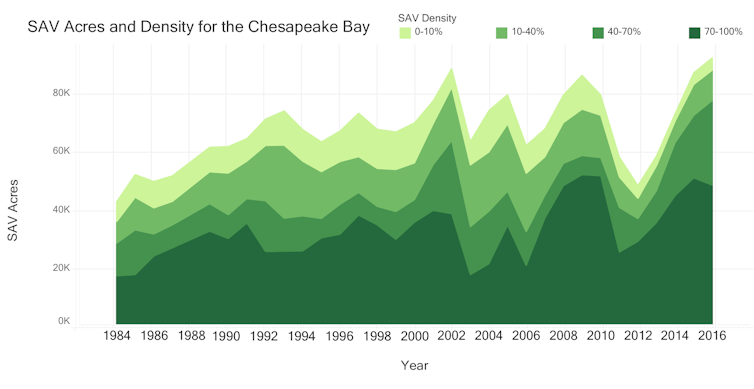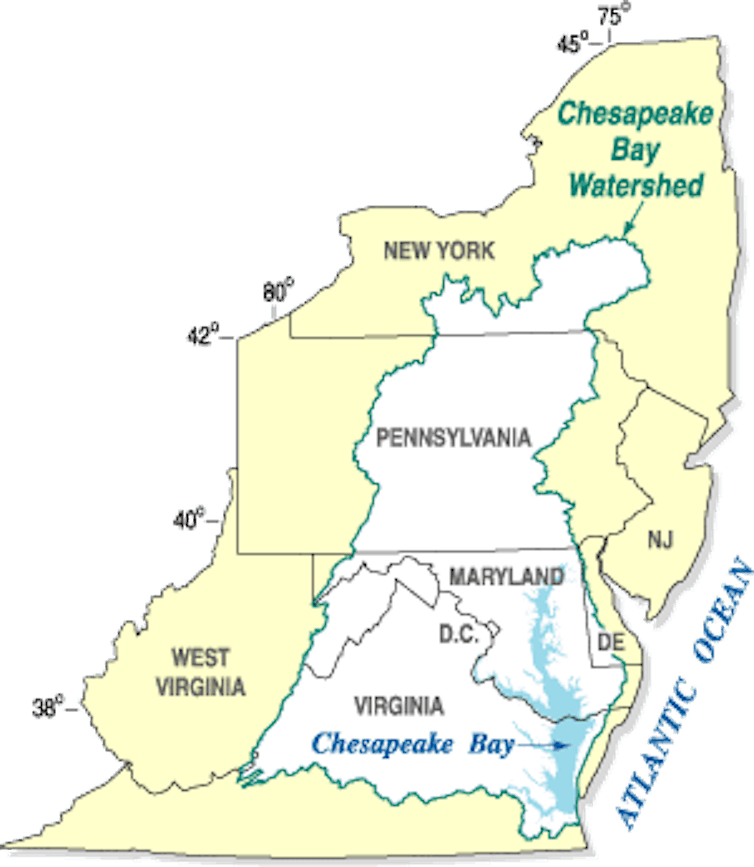Cutting pollution in the Chesapeake Bay has helped underwater grasses rebound
- Written by Bill Dennison, Professor of Marine Science and Vice President for Science Applications, University of Maryland Center for Environmental Science
Seagrasses are the “coastal canaries” of oceans and bays. When these underwater flowering plants are sick or dying, it means the ecosystem is in big trouble – typically due to pollution that reduces water quality. But when they are thriving and expanding, it is a sign that the ecosystem is becoming healthier.
We have collaborated on seagrass research for three decades in the Chesapeake Bay and beyond. One of us (Bob “JJ” Orth) has mapped and studied[1] the bay’s submerged aquatic vegetation since the 1980s. And the other (Bill Dennison) studies[2] seagrass ecophysiology and has led efforts to make this science understandable and useful.
Seagrasses are critical to a healthy Chesapeake Bay. They provide habitat for fish and shellfish, stabilize sediments and help clarify the water. The bay’s grasses declined sharply in the 1970s, as pollution and development degraded its water quality. States around the bay have been working together since 2010 on a sweeping plan to clean it up and restore its ecosystems.
In a new study[3], we provide conclusive evidence that reducing discharges of nitrogen, phosphorus and other pollutants into the bay has produced the largest resurgence of underwater grasses ever recorded anywhere. This success shows that coastal ecosystems are resilient and that concerted efforts to reduce nutrient pollution can result in substantial improvements.
 Trends in acreage and density of submerged aquatic vegetation in the Chesapeake Bay.
Melissa Merritt/USEPA, CC BY-ND[4]
Trends in acreage and density of submerged aquatic vegetation in the Chesapeake Bay.
Melissa Merritt/USEPA, CC BY-ND[4]
Cutting nutrient pollution boosts seagrasses
Ten years ago we led an effort through the National Center for Ecological Analysis and Synthesis[5] to understand the global trajectories of seagrasses. What we found was that seagrasses were being lost at an alarming rate[6], equivalent to a soccer field of seagrass every 30 minutes since 1980.
So when we began to observe net increases over the past few years in the abundance of multiple types of seagrasses (collectively known as submerged aquatic vegetation) in our beloved Chesapeake Bay, we knew this event was globally unique.
To discern what was happening, we partnered with the Chesapeake Bay Program[7] to initiate what is called a synthesis effort. Synthesis science brings together diverse teams of experts from different fields to pull new insights out of existing data.
 Pollution sources throughout the Bay’s watershed affect its water quality.
USGS[8]
Pollution sources throughout the Bay’s watershed affect its water quality.
USGS[8]
We had access to 30 years of annual surveys of underwater grasses that JJ Orth personally oversees, plus a 30-year water quality data set collected by the Chesapeake Bay Program. Scientists from the Virginia Institute of Marine Science[9], University of Maryland Center for Environmental Science[10], Bigelow Laboratory for Ocean Sciences[11], the U.S. Geological Survey[12], the National Socio-Environmental Synthesis Center[13], St. Mary’s College of Maryland[14], the Smithsonian Environmental Research Center[15], the Maryland Department of Natural Resources[16], Texas A&M University[17] and the U.S. Environmental Protection Agency[18] provided analytical firepower to help assess this complex information.
We started by identifying ways in which activities on land could affect trends in water quality and underwater grass abundance. Then we tested our hypothesized linkages using structural equation models that analyzed data in two different ways.
One approach focused on the cascade of nitrogen and phosphorus moving from sources on land, such as wastewater discharge and stormwater runoff, into waterways. The other showed what happened to underwater grasses once these nutrients entered in the water. Nutrients overfertilize the bay, creating huge blooms of algae that die and deplete oxygen from the water. This produces “dead zones[19]” that cannot support fish or plant life.
 Historic photos show water quality declining and underwater grasses disappearing off Solomons, Maryland.
Chesapeake Biological Laboratory/University of Maryland Center for Environmental Science, CC BY-ND[20]
Historic photos show water quality declining and underwater grasses disappearing off Solomons, Maryland.
Chesapeake Biological Laboratory/University of Maryland Center for Environmental Science, CC BY-ND[20]
In our analysis, we found conclusive evidence that reductions of excess nitrogen and phosphorus caused the underwater grass recovery in the Chesapeake Bay. Since 1984, the quantity of nitrogen entering the bay has decreased by 23 percent and phosphorus has fallen by 8 percent, thanks to a “pollution diet[21]” that the EPA established in 2010[22]. The plan, formally called a Total Maximum Daily Load (TMDL), requires states in the bay’s 64,000-square mile watershed to reduce specific pollutants entering the bay to target levels on a fixed schedule.
As a result, underwater grasses have increased by over 300 percent and have reappeared in some locations around the bay where they had not been observed for decades.
A healthier Chesapeake Bay
For the past 12 years, we have been using underwater grasses and other water quality data to produce an annual Chesapeake Bay report card[23]. Our 2017 report card describes progress across the board, with 7 out of 15 reporting regions around the bay showing significant improvement and the rest holding steady.
We attribute these improvements to the TMDL plan. In particular, upgrades at area wastewater treatment facilities[24] have reduced nitrogen and phosphorus inputs into the bay. Catalytic converters on automobiles and smokestack scrubbers in power plants[25] have reduced atmospheric nitrogen emissions and subsequent deposition that finds its way into bay waters. It appears that these management actions are beginning to pay off, although there is more to do – especially reducing nutrient pollution from agriculture.
Seagrasses in the Chesapeake Bay’s Susquehanna Flats are rebounding.Progress at risk
The Chesapeake Bay Program is a partnership between six states (New York, Pennsylvania, Maryland, Delaware, West Virginia, Virginia), the District of Columbia and the federal government, represented by the EPA. It heavily leverages federal funding by engaging community groups, local municipalities and nongovernmental organizations to carry out actions that help reduce pollution entering the bay. Examples include re-engineering urban surfaces to reduce stormwater runoff and subsidizing farmers to grow winter cover crops that help retain nutrients on fields.
When EPA Administrator Scott Pruitt was Oklahoma’s attorney general, he joined other states in a lawsuit to block the Chesapeake Bay cleanup, calling it a federal overreach. Now, however, Pruitt has pledged to support the program[26], which was upheld by a federal court in 2013[27] and sustained on appeal in 2015.
But President Trump’s 2017 budget called for eliminating the Chesapeake Bay Program completely. Congress enacted only small cuts, but Trump’s 2018 budget request cuts the program’s funding by 90 percent – ironically, just when we are finally starting to reverse degradation from past decades.
The Chesapeake Bay is arguably the best-studied estuary on the planet, and the fact that our study connects management actions to a huge resurgence of underwater grasses is a tribute to this rich history. Ongoing efforts to restore the bay have produced lessons about how pollution abatement can lead to ecosystem recovery.
These insights can and should be applied to other water bodies affected by nutrient pollution[28]. We hope the story of the Chesapeake Bay’s recovery inspires similar actions in many other places.
References
- ^ studied (scholar.google.com)
- ^ studies (scholar.google.com)
- ^ study (dx.doi.org)
- ^ CC BY-ND (creativecommons.org)
- ^ National Center for Ecological Analysis and Synthesis (www.nceas.ucsb.edu)
- ^ lost at an alarming rate (doi.org)
- ^ Chesapeake Bay Program (www.chesapeakebay.net)
- ^ USGS (upload.wikimedia.org)
- ^ Virginia Institute of Marine Science (www.vims.edu)
- ^ University of Maryland Center for Environmental Science (www.umces.edu)
- ^ Bigelow Laboratory for Ocean Sciences (www.bigelow.org)
- ^ U.S. Geological Survey (www.usgs.gov)
- ^ National Socio-Environmental Synthesis Center (www.sesync.org)
- ^ St. Mary’s College of Maryland (www.smcm.edu)
- ^ Smithsonian Environmental Research Center (serc.si.edu)
- ^ Maryland Department of Natural Resources (dnr.maryland.gov)
- ^ Texas A&M University (www.tamu.edu)
- ^ U.S. Environmental Protection Agency (www.epa.gov)
- ^ dead zones (doi.org)
- ^ CC BY-ND (creativecommons.org)
- ^ pollution diet (www.epa.gov)
- ^ established in 2010 (theconversation.com)
- ^ Chesapeake Bay report card (ecoreportcard.org)
- ^ upgrades at area wastewater treatment facilities (ian.umces.edu)
- ^ Catalytic converters on automobiles and smokestack scrubbers in power plants (dx.doi.org)
- ^ pledged to support the program (www.baltimoresun.com)
- ^ 2013 (www.epa.gov)
- ^ other water bodies affected by nutrient pollution (theconversation.com)
Authors: Bill Dennison, Professor of Marine Science and Vice President for Science Applications, University of Maryland Center for Environmental Science

